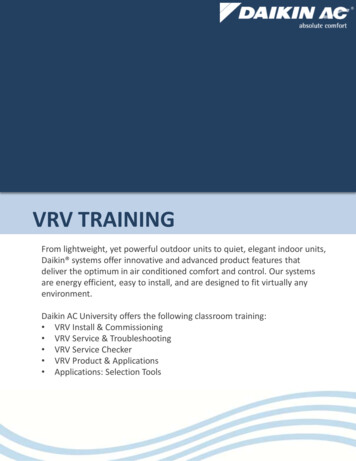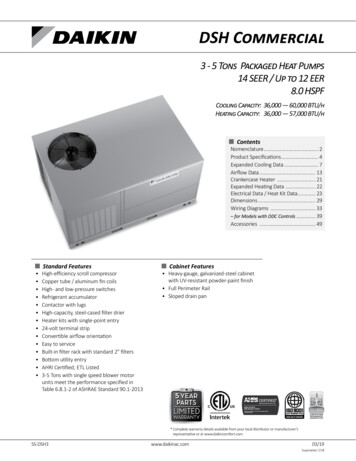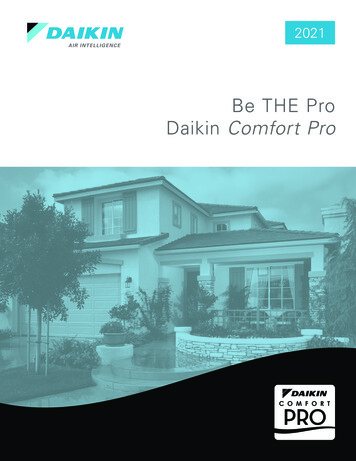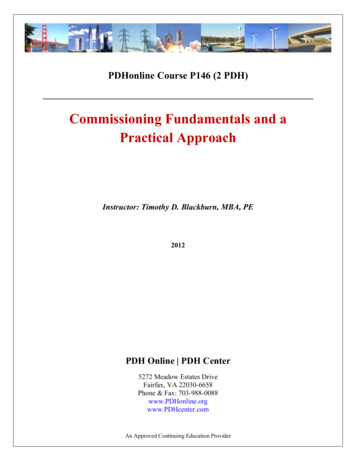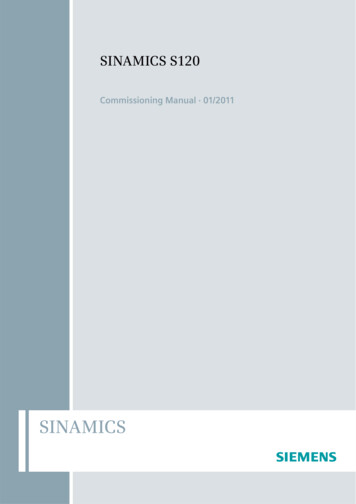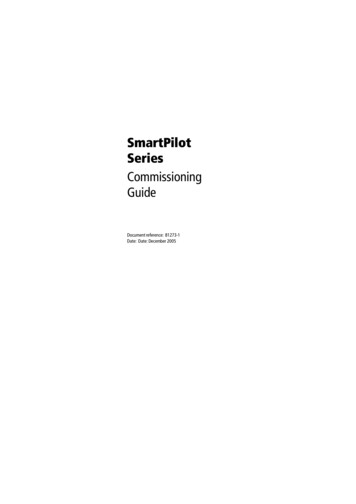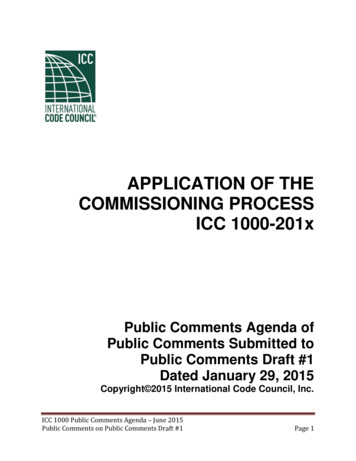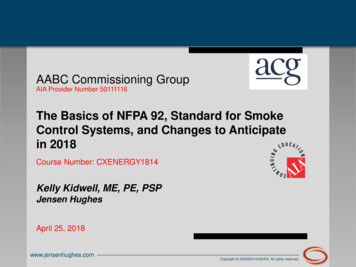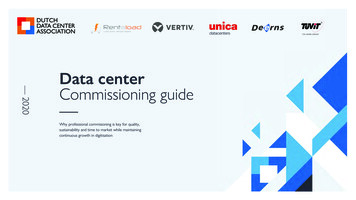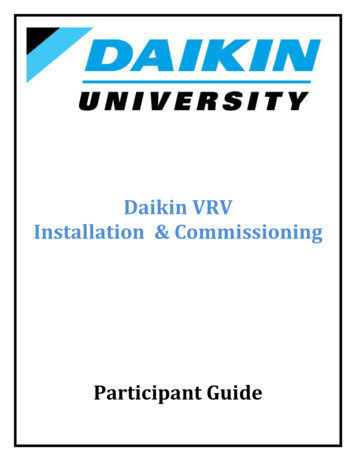
Transcription
Daikin VRVInstallation & CommissioningParticipant Guide
Daikin VRV Installation & CommissioningAgendaTraining ModulesTraining MaterialsSimulator Exercises
VRV I&C 1-Day Training AgendaClass IntroductionTraining Agenda & Handout ReviewVRV Prod. & Tech Review presentationBasic VRV Installation presentationVRVIII Component Control Wiring ExercisesBasic VRV RC Installation & Configuration presentationRemote Controller Simulator ExercisesVRVIII Commissioning Guide presentationVRVIII Commissioning Exercises – PCB SimulatorClass wrap-upTraining SurveysTraining End
Training Modules and MaterialsSlide Presentation ModulesVRV Prod & Tech Intro ReviewVRV Basic InstallationBasic VRV Remote Controller Installation & ConfigurationVRVIII Commissioning GuideMaterialsSimulatorsRemote Controller CD or DACA Controls Simulator BoxVRVIII Control PCB CDPrinted HandoutsVRVIII / VRVIII-S Service ManualsVRV-WIII Service Manual (optional)VRV RC Install & Config. BookletBasic VRV InstallationDIII-Net Wiring Quiz & Component Wiring ExercisesVRV Field SettingsVRVIII Commissioning Guide bookletVRV-WIII Commissioning Guide bookletMisc. MaterialsColored Pens or Pencils (Black – Blue – Red)Extra DIII-Net Wiring Quiz & Component Wiring Exercises
DIII-Net Control Wiring ExercisesExercise #1Write in your answers1. VRV DIII-Net Control Wire Specification:Indicate the DIII-Net Control Wire Specification2. Control Terminal Designations on VRVIII HP & HR Condensers:Indicate the Control Terminal Designations3. Control Terminal Designations on BSVQ Single Branch Selector Boxes:Indicate the Control Terminal Designations4. Control Terminal Designations on VRV Fan Coils:Indicate the Control Terminal Designations5. Control Terminal Designations on BRC1E71 and BRC2A71 Remote Controllers:Indicate the Control Terminal Designations
DIII-Net Control Wiring ExercisesDIII‐Net Wiring Exercise ExampleDraw in each circuit using a different color pencil or pen fromcomponent terminal to component terminal to indicate each controlcircuit – Indicate the “Daisy‐chain” wiring where required.## #### #### #### #### #### ##
DIII-Net Control Wiring ExercisesExercise #26 Ton Heat Pump with 3 zonesZone 1RXYQ72PBTJFXAQ18PVJUF1 F2F1 F2INF1 F2OUTQ1 Q2P1 P2Zone 2FXAQ18PVJUT1 T2F1 F2P1 P2Zone 3FXAQ18PVJUT1 T2F1 F2P1 P2FXAQ18PVJUT1 T2F1 F2P1 P2T1 T2
DIII-Net Control Wiring ExercisesExercise #312 Ton Manifolded Heat Pump with3 zones and i-Touch Multi-Zone ControllerRXYQ72PBYDRXYQ72PBYDZone 1F1 F2F1 F2INF1 F2OUTQ1 Q2F1 F2INF1 F2OUTP1 P2T1 T2Q1 Q2i-TouchZone 2F1 F2P1 P2T1 T2Zone 3F1 F2P1 P2T1 T2
DIII-Net Control Wiring ExercisesExercise #46 Ton Heat Recovery with 4 zonesREYQ72PBTJZone 1Zone 2Zone 3FXAQ18PVJUFXAQ18PVJUFXAQ18PVJUF1 F2P1 P2T1 T2F1 F2BSBoxF1 F2INF1 F2OUTQ1 Q2F1 F2OUTF1 F2INP1 P2T1 T2F1 F2BSBoxF1 F2OUTF1 F2INP1 P2Zone 4FXAQ18PVJUT1 T2F1 F2BSBoxF1 F2OUTF1 F2INP1 P2BSBoxF1 F2OUTF1 F2INT1 T2
DIII-Net Control Wiring ExercisesExercise #56 Ton Heat Recovery with 2 ZonesZone 1REYQ72PBTJFXAQ18PVJUF1 F2P1 P2T1 T2Zone 2FXAQ18PVJUF1 F2P1 P2FXAQ18PVJUT1 T2F1 F2P1 P2FXAQ18PVJUT1 T2F1 F2BSBoxF1 F2INF1 F2OUTQ1 Q2F1 F2OUTF1 F2INP1 P2BSBoxF1 F2OUTF1 F2INT1 T2
VRV SimulatorBRC1E71 Remote ControllerSimulator ExercisesTurn Controller Simulator ON or load Controller Simulator CDVerify the power-up sequence on the NAV Remote ControllerChange the Main Display from “STANDARD” to “DETAILED”Room TempDate & TimeDay of weekUse the “Field Settings Table” handout sheet for the following exercisesChange the Field Setting for “Priority of thermistor sensors for spacetemperature control” TO:“Only the Return Air Thermistor will be used”Change the “T1 T2” Field Setting TO: “ON/OFF” OperationVerify Field Setting Changes
VRV SimulatorVRVIII PCB “CD” Simulator CommissioningVRVIII Commissioning GuidePg. 44 Verify “Initialization” OperationPg. 56 Counting Indoor Fan Coil UnitsPg. 58 “Forced Fan On” ModePg. 60 Counting Branch Selector BoxesPg. 75 “Additional Refrigerant Charge” ModePg. 106 “Refrigerant Recovery/Evacuation” ModePg. 91 Initiate “Check Operation” Mode
4/23/2014 2014 Daikin North America, LLCSlide 1Introduction to DaikinA History of Integrity, Quality, Growth,and Cutting Edge Technology 2014 Daikin North America, LLCSlide 21
4/23/2014 Basic understanding of Daikin’s history Understand Daikin’s position in the global marketplace Understand Daikin’s commitment to the environment andthe industry Know what other resources are available to you and how touse them to your advantage Understand where to go for sales and technical supportSlide 3 2014 Daikin North America, LLCAbout DaikinIntroduction 2014 Daikin North America, LLCSlide 42
4/23/2014Daikin is a comprehensive global HVAC manufacturer offeringextensive products, including ducted and ductless air‐conditioning andheat pump systems for residential and commercial applications as wellas large‐sized HVAC systems for buildings and factories.Slide 5 2014 Daikin North America, t VRV system192419581982Beginsresearch onflourinerefrigerantsDevelopedfirst multi‐port mini‐split system19331969LaunchedAlthermaand 26‐SEERQuaternitySystem2009LaunchedVRV (VRVII & VRV‐S)in NorthAmericaAcquiredGoodmanManufacturing20122006 2014 Daikin North America, LLCSlide 63
4/23/20142014 Daikin ReleasesVRV IV 2014 Daikin North America, LLC Daikin is committed to providing homes, businesses andindustry with the most efficient HVAC solutions to meet yourcooling and heating needs, today and in the future. We are keenly aware of our responsibility to protect theenvironment in everything we do, and all our policies,practices and processes are developed and implementedwith environmental sustainability at their heart. We conductour business in accordance with green principles because itmakes sound economical, as well as ecological sense. 2014 Daikin North America, LLCSlide 7Slide 84
4/23/2014As the only company in the world dedicated to heating and air conditioning systemsand refrigerants, almost 90% of Daikin’s core business is focused on HVAC‐R. Daikinleads the way in energy efficiency, individualized comfort, and quality and is the #1 inHVAC manufacturing sales worldwide.17 Billion USDWorld %Other38%28%11%Europe, MiddleEast, & AfricaChina, SoutheastAsia, & OceaniaNorth, Central,& SouthAmerica 2014 Daikin North America, LLCSlide 9Who has made the largest investment in the North AmericanHVAC industry over the last 8 years? Daikin. 2014 Daikin North America, LLCSlide 105
4/23/2014 2014 Daikin North America, LLCSlide 11 Recover – Recycle – Reclaim – Reuse Partnerships with AHRI, ASHRAE and others 2014 Daikin North America, LLCSlide 126
4/23/2014Reduce CO² with Heat Pump SystemsFossil FuelsHeat PumpsSlide 13 2014 Daikin North America, LLCDaikin North AmericaIntroduction 2014 Daikin North America, LLCSlide 147
4/23/2014Our vision is to be the premier provider of the highest qualityair conditioning products, systems, services, and solutions inNorth America by focusing on outstanding, long‐term customerservice.To accomplish this, we will continue to hire the best people,always conduct our business easily and fairly, and operate withthe highest degree of integrity in all business practices.In order to attract and retain the best people, we are committedto providing the best training and creating an atmosphere ofteamwork where we help each other grow. 2014 Daikin North America, LLCSlide 15Daikin North AmericaTechnical Service & Training CenterCarrollton, TX 2014 Daikin North America, LLCSlide 168
4/23/2014Daikin North AmericaWestern Regional Sales & Training CenterIrvine, CA 2014 Daikin North America, LLCSlide 17Daikin North AmericaEastern Regional Sales & Training CenterLong Island City in Queens, NY 2014 Daikin North America, LLCSlide 189
4/23/2014 2014 Daikin North America, LLC 2014 Daikin North America, LLCSlide 19Slide 2010
ZOKNMARTXCE: Central RegionNE: North East RegionSE: South East RegionSO: Southern RegionWC: West CoastSCALMSGALASO 2014 Daikin North America, LLCSEFLSlide 21 Literature Brochures Leaflets Submittals Manuals Engineering Service Installation Website www.Daikinac.com Daikin Representativesand Sales Support Network 2014 Daikin North America, LLCSlide 2211
4/23/2014 Software Tools VRV Xpress Energy Calc TRL Technical Reference Library Spare Parts Bank Dr. Daikin Daikin eQuip App Training Product & Applications by Product Line Installation & Commissioning Service & Troubleshooting Sales Training General Courses Technical Support Email: techsupport@daikinac.com or servicerequest@daikinac.com 2014 Daikin North America, LLC Slide 23Daikin eQuip is designed for both smart phones and tablets. It placesinformation in your hands quickly and easily for all of your on‐the‐goneeds. Whether you’re a Daikin partner, dealer, engineer, or just interestedin the Daikin product, you can: SEARCH product information to quickly access and download your mostreferenced documents. SEND key information via email or text message (SMS) for immediate sharing. RETRIEVE instant updates for the most up‐to‐date news and information onDaikin AC.Search for Daikin eQuip in the APP store orAndroid Market! 2014 Daikin North America, LLCSlide 2412
4/23/2014 Basic understanding of Daikin’s history Understand Daikin’s position in the global marketplace Understand Daikin’s commitment to the environment andthe industry Know what other resources are available to you and how touse them to your advantage Understand where to go for sales and technical support 2014 Daikin North America, LLCThank YouPT‐INF‐1211‐PP0‐01C 2014 Daikin North America, LLCSlide 25PT‐RLC‐1306‐PP ‐01ASlide 2613
4/23/2014Slide 1 2013 Daikin North America, LLCPiping & R‐410AField Practices for Piping and ChargingDaikin Air Conditioning Equipment 2013 Daikin North America, LLCSlide 21
4/23/2014 Refrigerant recovery and the atmosphere Properties of R‐410A PVE oil Identify line set components Daikin dedicated tools Flared connections 2013 Daikin North America, LLC Brazing Standing pressure test and leak testing Triple evacuation process Pipe insulation Importance of liquid charging 2013 Daikin North America, LLCSlide 3Slide 42
4/23/2014Recover – Recycle – Reclaim ‐ ReuseDaikin cares for our environmentSlide 5 2013 Daikin North America, LLCR‐410A 2013 Daikin North America, LLCSlide 63
4/23/2014 Developed since 1991Ozone friendly ‐ No ChlorineLower Significant ODP than R22Near Azeotrope50/50 MixtureTemperature Glide .02 FNot compatible with mineral oilsGenerally non toxic, non flammableNearAzeotropeSlide 7 2013 Daikin North America, LLC Recovery cylinder must be rated for R‐410A 400 PSIG Service Pressure Rated 800 PSIG Test Pressure Rated DOT BA400, DOT BW400R‐410AStore refrigerants in a clean, dry area outof direct sunlight. Never heat cylindersabove 125 F(52 C). 2013 Daikin North America, LLCSlide 84
4/23/2014 Asphyxia Heavier than air Products of Decomposition Skin Irritant Frostbite Storage below 125 F ASHRAE111HMIS 1Do not leak test with air20NFPA 704 2013 Daikin North America, LLCSlide 9Pressure is approximately 60% higher than with R‐22Adequate tools and service devices needed 2013 Daikin North America, LLCSlide 105
4/23/2014Working with PVE OilSlide 11 2013 Daikin North America, LLCR‐410A & Mineral Oil 2013 Daikin North America, LLCR‐410A & PVE OilSlide 126
4/23/2014 PVE oil is optimal for systems that do not use line set driers Compatible with all HFC Refrigerants Excellent anti‐wear properties Better solubility with process fluids Superior Resistance to Cap tube blockage Better lubricity Optimal for non‐drier systems Very Hygroscopic but with no hydrolysis Moisture easily removedSlide 13 2013 Daikin North America, LLCRefrigerant Lines 2013 Daikin North America, LLCSlide 147
4/23/2014Only install driers, oil traps, shut off valves or any other linecomponents in your piping work if instructed to do so in theIOM documents – if no instruction, it’s because it is NOTnecessary (for Daikin).The only acceptable piping is ACR (copper) type tubing whichis dehydrated and sealed at both ends. 2013 Daikin North America, LLCSlide 15We do not recommend Isolation Valves be installed in Daikinsystems; however, there are times when the specifications requirethem: Compatibility with R‐410A and PVE (Polyvinylether) oil Temperature operation range of ‐40 F to 300 F Working pressure of 550 PSIG, capable of handling up to 700PSIG Full flow valve with 0 pressure drop Bi‐directional flow Brazed connections Service port in valve body 2013 Daikin North America, LLCSlide 168
4/23/2014100 F x 100 ft x 12 in./ft. x 0.0000094 in./in./F 1.128 in.Reference: The Copper Tube Handbook published by Copper.org ‐ the #1 resource for technical and professional informationregarding copper and copper alloys.Slide 17 2013 Daikin North America, LLCPoint of tensionClampsNoMovement 2013 Daikin North America, LLCAlternativeMovementSlide 189
4/23/2014Slide 19 2013 Daikin North America, LLC50 F 2013 Daikin North America, LLC186 FSlide 2010
4/23/2014Refrigerant Line InsulationSlide 21 2013 Daikin North America, LLC 2013 Daikin North America, LLCRefrigerant piping must bemaintained cleanDuring the course ofinstallation, the refrigerantlines should beoccasionally blown outwith dry nitrogen to driveout any particulate debrisWhen the piping is notconnected to the indoorand outdoor units, theends must be properlysealedSlide 2211
4/23/2014ALL pipe work must beinsulated along its full runusing 3/4” Wall Insulationminimum.Take extra care to cover theflare nuts on the fan coilsusing the insulationprovided or condensationwill occur causing waterleaks.The liquid line must be insulatedAlways follow local codesCould cause excessivesubcooling.Slide 23 2013 Daikin North America, LLCInsulation of support brackets 2013 Daikin North America, LLCSlide 2412
4/23/2014Keep copper ends sealed to preventdebris from settling in the piping.Pinched & brazedCapped or tapedWhen the refrigerant lines are not connected and dormant duringconstruction there are two recommended methods of sealing the ends 30 days cap or tape the ends 30 days pinch and braze the endsSlide 25 2013 Daikin North America, LLCTools 2013 Daikin North America, LLCSlide 2613
4/23/2014 All of our serviceconnections are 5/16” Dedicated manifold R‐410A Rated up to 550and 800 PSIG 5/16” hose connectionsHose Pressure 800 PSIG Rated 2013 Daikin North America, LLC 2013 Daikin North America, LLCSlide 27Slide 2814
4/23/2014Torque Wrench KitPart No. TLTWSM 2013 Daikin North America, LLC Service Tool KitDACA‐99S TK‐1Slide 29Pump capacity should be aminimum of 6 cfmVacuum pump should have acheck valvePump must be kept properlymaintainedChange pump oil frequently 2013 Daikin North America, LLCSlide 3015
4/23/2014 As driers are not used in VRV refrigerant lines it is imperative to properlyevacuate the system to remove all moisture to insure a dry systemAll Daikin systems must be triple evacuated down to 500 microns or less The moisture level can only be determined with an accurate microngauge Never evacuate a refrigeration system using atmospheric pressurealone500m 2013 Daikin North America, LLC Slide 31Daikin systems are charged with R‐410A refrigerant by weight based onthe length of the liquid lines All liquid lines should be measured as accurately as possible to insureoptimum system performance Each liquid line diameter is multiplied by a factor per measured foot of pipinglength The refrigerant charge is designated as the “Additional Refrigerant Charge” A good digital scale must be used to properly weigh in the liquid R‐410Arefrigerant 2013 Daikin North America, LLCSlide 3216
4/23/20145/16” ValveCore RemovalTool w/sideportMetric Hex Keys3/8”Nitrogen RegulatorRated 750‐1000 PSIG1/4”Slide 33 2013 Daikin North America, LLCFlaring 2013 Daikin North America, LLCSlide 3417
4/23/2014Proper deburring is critical to a successful flareSlide 35 2013 Daikin North America, LLC“B” depth for ¼”pipeGo / No GoBFlaringBlockADACA‐FSG‐1“B” depth for all other sizesDimension “A” requirementDimension “B” RequirementPipe SizeDimensionPipe SizeDimension1/4”9.1mm1/4”1 mm3/8”13.2mm3/8”2 mm1/2”16.6mm1/2”2 mm5/8”19.7mm5/8”2 mm3/4”24.0mm3/4”2 mm 2013 Daikin North America, LLCSlide 3618
4/23/2014BrazingSlide 37 2013 Daikin North America, LLCDry Nitrogen MUST be used during all brazing(Pressure regulated to 1.5 to 3 PSIG) to preventoxidation formation Tape in Schrader Fitting Set Nitrogen regulator to1.5 – 3 PSIG Leave other end of pipeopen 2013 Daikin North America, LLCSlide 3819
4/23/2014Pressure Test & EvacuationSlide 39 2013 Daikin North America, LLCVerify all stop valves are securely closed before pressure test550 psiMax. pressure for anysystem installed with one ormore FXTQ Air Handlers450 psiOR325 psi150 psi3 Min 2013 Daikin North America, LLC5 Min24 Hr24 HrSlide 4020
4/23/2014Use commercial liquid leakdetector 2013 Daikin North America, LLCSlide 41What is a micron as a unit of measurement for a vacuum? 2013 Daikin North America, LLCSlide 4221
4/23/2014Daikin Recommends Triple Evacuation Evacuate the system to 4000 microns and hold for 15minutes Break vacuum with dry nitrogen to a pressure of 2‐3 PSIGand hold for 20 minutes Evacuate to 1500 microns and hold for 20 minutes Break vacuum with dry nitrogen to a pressure of 2‐3 PSIGand hold for 20 minutes Evacuate below 500 microns and hold for 60 minutesSlide 43 2013 Daikin North America, LLCAtmosphericpressureVacuumService portsShutoff valveVacuum pumpmineral oil level 2013 Daikin North America, LLCSlide 4422
4/23/2014System Refrigerant Charging 2013 Daikin North America, LLCSlide 45Weigh in additional refrigerant with digital scales Calculate charge based on total line length x lb/ft ofdiameter. Check with each model for correct multiplier. 2013 Daikin North America, LLCSlide 4623
4/23/2014 The ozone is only part of the equation in refrigerant containment andrecycling. R‐410A is a very efficient blended refrigerant but it requires knowledgeand skills to be used correctly and safely. Daikin chose PVE as for its properties and easier system dehydration. Daikin does not require dryers, sight glasses, or oil traps on systeminstallations. Expansion must be taken into consideration to prevent fractures or cracksin the gas lines due to temperature increases. Daikin recommends a dedicated tool set including gauges for working onDaikin equipment. 2013 Daikin North America, LLC R‐410A systems require a different flaring block for making flaredconnections. Dry nitrogen purge while brazing prevents oxidation inside of the lines. Pressure test and evacuation must be completed according to bestpractices in the industry. All lines must be insulated including the liquid and the condensate lines. Daikin requires R‐410A to be charged as a liquid and a complete recoveryand recharge in the event of a leak. 2013 Daikin North America, LLCSlide 47Slide 4824
4/23/2014Thank YouPT‐CAP‐1305‐PP0‐01C 2013 Daikin North America, LLCPT‐RLC‐1306‐PP ‐01ASlide 4925
1/18/2013DAIKIN VRVProduct & Technology IntroductionReviewRESIDENTIAL LIGHT COMMERCIAL COMMERCIALTraining DepartmentSeptember 2012 2012 Daikin ACDaikin VRV ConceptWhat is VRV ? Variable - System capacity varies with loadRefrigerant - R-410A Direct Expansion SystemVolume - Refrigerant flow regulated by EEV’sand a variable speed compressorVRV - Daikin Registered trademarkIntroduced in 1982 – Worlds first VRF systemOver 1 million installations worldwideOver 25,000 systems in the US and Cana
and refrigerants, almost 90% of Daikin’s core business is focused on HVAC‐R. Daikin leads the way in energy efficiency, individualized comfort, and quality and is the #1 in HVAC manufacturing sales worldwide. 87% 10% 3% Sales HVAC‐R Fluoro‐ chemicals Other 38% 2
